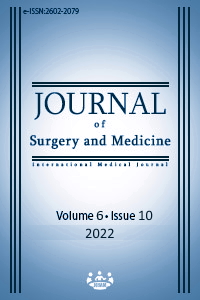Timing of cesarean delivery for women with four or more previous cesarean sections
Timing of repetitive cesarean delivery
Keywords:
Cesarean section, Timing, Maternal outcome, Neonatal outcomeAbstract
Background/Aim: The number of recurrent cesareans is increasing worldwide, but the optimal timing for delivery in women who have had previous cesareans is controversial. The aim of this study is to determine the optimal timing of elective cesarean delivery in women with a history of four or more cesarean sections (CSs).
Methods: This retrospective cohort study was conducted in a tertiary hospital; 195 patients with a history of four or more CSs were grouped according to their gestation weeks on operation day and analyzed in terms of demographic features and clinical data as well as maternal and neonatal outcomes. Gestation weeks were grouped as 37-38 weeks and 39 weeks. Logistic regression analysis was used to determine the effect of independent variables on maternal and fetal outcomes.
Results: Of the 195 patients, 118 had CS between 37-38 weeks and 77 at 39 weeks. Clinical and demographic characteristics were similar among groups. The overall maternal complication did not differ between the groups (16.1% vs 16.9%, P = 0.885). The 1st and 5th minute APGAR scores were significantly lower in the 37-386 weeks group (P = 0.013 and P = 0.04, respectively). Logistic regression analysis found that neonatal 5th minute APGAR score was associated with a model including maternal age, number of previous CS, anesthesia type, gestational week at delivery, and neonatal birth weight.
Conclusion: Timing CS at 39 weeks in patients with a history of four or more CSs was found not to worsen maternal outcomes. Additionally, planning at 39 weeks could improve newborn outcomes.
Downloads
References
Boerma, T, Ronsmans C, Melesse DY, Barros A, Barros FC, Juan L, et al. Global epidemiology of use of and disparities in caesarean sections. Lancet (London, England). 2018;392(10155):1341-8. doi: 10.1016/S0140-6736(18)31928-7 DOI: https://doi.org/10.1016/S0140-6736(18)31928-7
Elnakib S, Abdel-Tawab N, Orbay D, Hassanein N. Medical and non-medical reasons for cesarean section delivery in Egypt: a hospital-based retrospective study. BMC Pregnancy Childbirth. 2019;19(1):411. doi: 10.1186/s12884-019-2558-2 DOI: https://doi.org/10.1186/s12884-019-2558-2
Wilmink FA, Hukkelhoven CWPM, Lunshof S, Mol BWJ, van der Post JAM, Papatsonis DNM. Neonatal outcome following elective cesarean section beyond 37 weeks of gestation: a7-year retrospective analysis of a national registry. Am J Obstet Gynecol. 2010;202(3):250.e1-8. doi: 10.1016/j.ajog.2010.01.052 DOI: https://doi.org/10.1016/j.ajog.2010.01.052
Rossi AC, D’Addario V. Maternal morbidity following a trial of labor after cesarean section vs elective repeat cesarean delivery: a systematic review with meta-analysis. Am J Obstet Gynecol. 2008;199(3):224-31. doi: 10.1016/j.ajog.2008.04.025 DOI: https://doi.org/10.1016/j.ajog.2008.04.025
Caesarean section. London: National Institute for Health and Care Excellence (NICE), 2019 Sep. PMID: 31944642. Caesarean Section. London; 2019.
Roberts CL, Nicholl MC, Algert CS, Ford JB, Morris JM, Chen JS. Rate of spontaneous onset of labour before planned repeat caesarean section at term. BMC Pregnancy Childbirth. 2014;14:125. doi: 10.1186/1471-2393-14-125 DOI: https://doi.org/10.1186/1471-2393-14-125
Melamed N, Hadar E, Keidar L, Peled Y, Wiznitzer A, Yogev Y. Timing of planned repeat cesarean delivery after two or more previous cesarean sections--risk for unplanned cesarean delivery and pregnancy outcome. J Matern Neonatal Med. 2014;27(5):431-8. doi: 10.3109/14767058.2013.818130 DOI: https://doi.org/10.3109/14767058.2013.818130
Landon MB, Spong CY, Thom E, Hauth JC, Bloom SL, Varner MW, et al. Risk of uterine rupture with a trial of labor in women with multiple and single prior cesarean delivery. Obstet Gynecol. 2006;108(1):12-20. doi: 10.1097/01.AOG.0000224694.32531.f3 DOI: https://doi.org/10.1097/01.AOG.0000224694.32531.f3
Breslin N, Vander Haar E, Friedman AM, Duffy C, Gyamfi-Bannerman C. Impact of timing of delivery on maternal and neonatal outcomes for women after three previous caesarean deliveries; a secondary analysis of the caesarean section registry. BJOG. 2019;126(8):1008-13. doi: 10.1111/1471-0528.15652 DOI: https://doi.org/10.1111/1471-0528.15652
Helwick C. Repeat cesarean delivery optimal before 39 weeks. Paper presented at: Society for Maternal-Fetal Medicine (SMFM) 34th Annual Meeting. http://www.medscape.com/viewarticle/820391. Accessed March 24, 2016.
Tita A, Lai Y, Landon MB, Spong CY, Leveno KJ, Varner MW, et al. Timing of elective repeat cesarean delivery at term and maternal perioperative outcomes. Obstet Gynecol. 2011;117(2 Pt 1):280-86. doi: 10.1097/AOG.0b013e3182078115 DOI: https://doi.org/10.1097/AOG.0b013e3182078115
Tita ATN. What we have learned about scheduling elective repeat cesarean delivery at term. Semin Perinatol. 2016;40(5):287-90. doi: 10.1053/j.semperi.2016.03.004 DOI: https://doi.org/10.1053/j.semperi.2016.03.004
Mohammed A-BF, Bayo AI, Abu-Jubara MF. Timing of elective repeated cesarean delivery in patients with previous two or more cesarean section. J Matern Neonatal Med. 2013;26(1):10-12. doi: 10.3109/14767058.2012.718001 DOI: https://doi.org/10.3109/14767058.2012.718001
Hamadneh J, Alchalabi H, Hamadneh S, Amarin Z, Khader YS, Kassab M, et al. Association between timing of elective cesarean delivery and adverse outcomes among women with at least two previous cesareans. Int J Gynaecol Obstet. 2017;137(1):51-6. doi: 10.1002/ijgo.12089 DOI: https://doi.org/10.1002/ijgo.12089
Hu Y, Shen H, Landon MB, Cheng W, Liu X. Optimal timing for elective caesarean delivery in a Chinese population: a large hospital-based retrospective cohort study in Shanghai. BMJ Open. 2017;7(6):e014659. doi: 10.1136/bmjopen-2016-014659 DOI: https://doi.org/10.1136/bmjopen-2016-014659
Shinar S, Walsh L, Roberts N, Melamed N, Barrett J, Riddell C, et al. Timing of cesarean delivery in women with ≥2 previous cesarean deliveries. Am J Obstet Gynecol. 2022;226(1):110.e1-110.e10. doi: 10.1016/j.ajog.2021.07.018 DOI: https://doi.org/10.1016/j.ajog.2021.07.018
Kadour-Peero E, Bleicher I, Vitner D, Sloma R, Bahous R, Levy E, et al. When should repeat cesarean delivery be scheduled, after two or more previous cesarean deliveries? J Matern Neonatal Med. 2018;31(4):474-80. doi: 10.1080/14767058.2017.1288208. DOI: https://doi.org/10.1080/14767058.2017.1288208
Downloads
- 1862 1140
Published
Issue
Section
How to Cite
License
Copyright (c) 2022 Nergis Kender Erturk , Nermin Kilicarslan
This work is licensed under a Creative Commons Attribution-NonCommercial-NoDerivatives 4.0 International License.
















